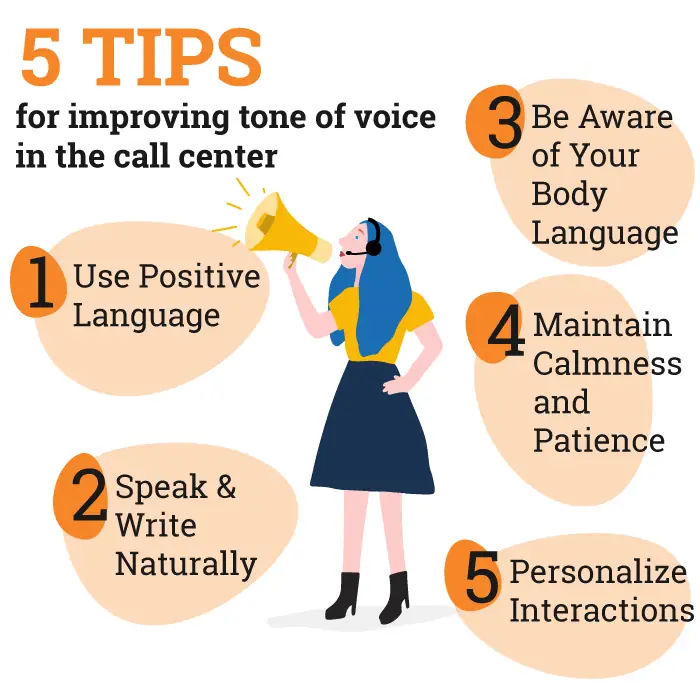In the call center industry, we focus so much on what we say to customers. We write scripts, teach language best practices, and memorize empathy statements. But did you know that verbal language accounts for only 7% of how one is perceived? That means that non-verbal cues such as tone of voice and body language make up 93% of people's opinions of you. So maybe we should start focusing more on how something is being said.
This blog delves into five simple yet effective tips for improving the tone of voice in call centers. It offers practical advice that agents can implement immediately to enhance communication skills and customer experiences. Whether you're a seasoned professional aiming to refine your approach or a newcomer eager to make a positive impact, these insights will guide you in mastering the art of verbal communication, laying the foundation for improved customer interactions and service excellence.
Why Is Tone of Voice So Important in the Call Center?
The tone of voice in customer interactions directly influences customers' perception of the service they receive. Regardless of the issue's resolution, it can make the difference between a perceived negative or positive experience. A friendly, empathetic tone can soothe frustrated callers and build trust, turning a potentially negative experience into a positive one. Conversely, an indifferent or negative tone can escalate conflicts, driving customers away.
Tone of voice in customer service is not just about how you say something; it's about what your words convey to the person on the other end of the conversation. It’s a powerful tool that can make or break your interaction. In customer service, your tone can significantly impact a customer’s experience, emotions, and perception of your brand. It sets the atmosphere of the interaction and plays a critical role in shaping the customer's overall satisfaction.
An agent's tone of voice is extremely important for improving customer experience. Albert Mehrabian’s communication model states that tone of voice is over five times more impactful than word choice in a conversation. By improving the tone of voice, you can significantly improve customer satisfaction and first call resolution and increase call center cost savings.
SQM's research shows that an agent's tone of voice correlates with the acceptance rate when conducting post-call surveys. In fact, a customer is almost twice as likely to stay on the line and answer the customer satisfaction survey questions when the agent uses an upbeat tone rather than a lower tone.
Training agents to greet callers with a cheerful and enthusiastic tone can quickly boost Customer Satisfaction (CSat) and Net Promoter Score (NPS). The tone of voice is crucial in demonstrating genuine interest and attentiveness to the customer's needs. When customers sense they have your undivided focus, they're far more likely to be satisfied with the service provided.
5 Tips for Improving Tone of Voice in the Call Center

Tip 1: Use Positive Language

Incorporating positive language into your customer service interactions is a surefire way to improve your tone of voice. Positive language focuses on solutions and makes the customer feel understood and appreciated. This shift towards a more optimistic interaction can greatly influence the customer’s perception and response.
Instead of highlighting what can't be done, emphasize what you can do and offer alternatives when possible. It’s about framing your responses to focus on the positive aspects, even in challenging situations.
Examples of Positive Phrases
- Instead of saying, "I don’t know," say, "Let me find out for you."
- Swap "That’s not something we do," with "Here’s what we can do for you."
- Replace "You’ll have to" with "You might find it helpful to…"
- Instead of "Hold on," try, "Would you mind holding for a moment while I check that for you?"
- Exchange "No problem" for "Absolutely, I’d be happy to assist with that."
Using these phrases can significantly alter the tone of the conversation, making it more positive and customer-focused.
The effects of positive language on customers are profound and multifaceted. Positive language improves the immediate interaction and has long-term benefits for customer relations. Research shows that using positive language can lead to increased Csat, more amicable resolutions to problems, and a higher likelihood of customers recommending your service to others.
When customers feel heard and valued, they’re more understanding, cooperative, and forgiving. Moreover, this positive experience is crucial in retaining customers and encouraging loyalty. Using positive language is an effective strategy to enhance your tone of voice, turning standard customer service into exceptional customer service.
Tip 2: Speak and Write Naturally

The foundation of an effective communication tone is authenticity. Call center agents are encouraged to speak and write in a natural, conversational style. This approach makes interactions feel more personal and less scripted, fostering a genuine connection between the agent and the customer.
For example, agents should avoid reading their scripts word for word and instead try to add a personal touch to the conversation. This can look like:
- “I completely understand; my kids are the same way.”
- “Don’t worry – it happens to me all the time.”
- “That would frustrate me as well. Let me see how I can help.”
When customers sense sincerity, they're more likely to respond positively, even in challenging situations. Therefore, agents should strive to use natural language, adjusting their speech to match the customer's tone and pace without sacrificing professionalism.
Tip 3: Be Aware of Your Body Language

Body language and facial expressions make up 93% of in-person communication. But what about when communication is over the phone rather than in person? When body language is hidden, does it still matter? The answer is yes.
When agents speak on the phone to a customer, they could be lying on their bed, slumped over their desk, or standing up, which the customer likely wouldn't know. Or would they? The truth is that posture and facial expressions strongly impact your tone of voice. There is a clear difference in tone of voice between someone sitting upright and someone slouched over.
How you hold yourself impacts your breathing, influencing how you sound when you speak. Slouching compresses your chest, limiting your breath and making speaking more challenging. This can result in your voice sounding flat and disengaged during phone conversations.
Moreover, sitting with your chin near your chest or slouching constricts your vocal cords, leading to a muffled and quieter voice. Conversely, maintaining an upright posture with a straight back allows your voice to come through more clearly and with a more positive tone. Give it a try yourself and observe how your posture affects how you sound over the phone.
Facial expressions also significantly influence our tone. Have you ever “heard” a smile in someone's voice during a phone call? If so, it wasn't your imagination. Facial expressions alter the muscles in our face and neck, which directly impacts how our voice sounds.
For instance, our voices tend to sound deeper and strained when we frown. Conversely, when we smile, our voices become higher-pitched and more cheerful. That's precisely why many agents are coached to smile as they pick up the phone.
Tip 4: Maintain Calmness and Patience

Maintaining calmness and patience in customer service is paramount. Customers are likely to remember the emotional tone of an interaction more vividly than the actual words spoken. Therefore, ensuring that you remain composed and patient, regardless of the situation, can significantly enhance your tone of voice and, by extension, the customer's experience.
Strategies to Stay Calm Under Pressure
To stay calm under pressure, start by taking deep, slow breaths. This simple technique can help decrease stress levels and increase your ability to remain poised. Furthermore, practice active listening. Focus on the customer's words without interrupting, which can help you understand their perspective and formulate a more effective response.
Additionally, try to keep a positive mindset; remind yourself that the goal is to solve the problem, not to escalate the situation. Finally, don't take things personally. Remember, the customer's frustration is not directed at you as an individual but at their situation.
Handling Challenging Customer Situations with Patience
When faced with challenging customer situations, patience is your strongest ally. Here are a few practical steps to ensure patience in every customer interaction:
- Acknowledge the customer's feelings and apologize for any inconvenience caused, even if the problem was not your fault. This can help defuse tension and show empathy.
- Use a calm and slow tone of voice. This conveys control and reassures the customer that you are handling the situation.
- Ask clarifying questions. This demonstrates your intent to understand and solve the problem thoroughly.
- Set clear expectations for the resolution process, including any steps the customer needs to take or how long they should expect to wait for a resolution.
Tip 5: Personalize Interactions

Personalizing interactions in customer service goes beyond using the customer’s name. It involves tailoring your communication to meet each customer's unique needs and preferences. Personalization can transform a standard customer service exchange into an exceptional, memorable experience.
Ways to Personalize Customer Service Conversations
- Use the Customer's Name: Addressing the customer by name throughout the conversation makes interactions more friendly and personalized.
- Remember Past Interactions: Referencing previous interactions, where relevant, shows the customer they are remembered and valued.
- Tailor Recommendations: Offer personalized suggestions or solutions based on the customer's purchase history or preferences.
- Adjust Your Communication Style: Adapt your tone and language based on the customer’s mood and communication style. For example, a distressed customer might require a more empathetic approach, while a happy customer might appreciate a cheerier tone.
- Celebrate Special Occasions: If possible, note special occasions like birthdays or anniversaries in your CRM to celebrate with your customers, demonstrating you value them beyond just transactions.
By integrating these personalization techniques into your customer service strategy, you can significantly improve your tone of voice, making every customer feel valued and understood. This not only boosts the quality of customer interactions but also enhances overall customer satisfaction and loyalty.
